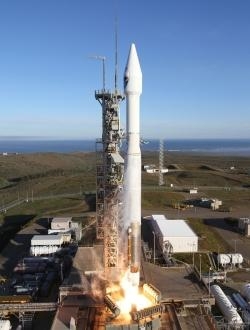Sat, Apr 05, 2014
Defense Meteorological Satellite Program Spacecraft Entering Polar Orbit
A Defense Meteorological Satellite Program (DMSP) satellite built was successfully launched Thursday at 0746 PDT from Vandenberg Air Force Base in California atop an Atlas V rocket. Lockheed Martin, which built the satellite, confirmed signal acquisition shortly after launch.

DMSP-19 is the fourth Block 5D-3 version to be launched, and Lockheed Martin has produced more than 40 satellites throughout the program’s 50-year history. Many of the satellites are performing beyond their design life, so adding on-orbit capability is important for reliable weather information.
“Lockheed Martin and the Air Force have partnered on DMSP for more than 50 years, and it’s an effective team. The constellation is significantly outliving its design life,” said Sue Stretch, DMSP program director at Lockheed Martin. “This new satellite informs some of the most important decisions in the armed forces, from flight patterns to troop movements. Simply put, weather data is essential to both our military operations and civilian safety."
The satellite launched Thursday is equipped with a sophisticated sensor suite that can capture visible and infrared cloud cover; measure precipitation, surface temperature and soil moisture; and collect specialized global meteorological, oceanographic and solar-geophysical information in all weather conditions. DMSP-19 joins six other satellites in polar orbit providing weather information.
Several features on DMSP-19 improve reliability and performance. Those include a more capable power subsystem, an upgraded on-board computer and better battery capacity that extends mission life. Additionally, the satellite carries a new attitude control subsystem and a star tracker. The current Block 5D series also accommodates larger sensor payloads than earlier generations.
The nation’s space weather capability extends beyond DMSP. Lockheed Martin continues to modernize that mission through the NASA and National Oceanic and Atmospheric Administration’s Geostationary Operational Environmental Satellite R-Series (GOES-R), scheduled to launch in 2016.
At the launch, Lockheed Martin hosted five teachers from Industry Initiatives for Science and Math Education (IISME), which matches teachers with industry so they see how science, technology, engineering and math (STEM) applies in the workforce. Afterward, employees visited a local elementary school to lead three STEM activities as part of Lockheed Martin’s Launch and Learn program, designed to bring STEM-related activities to launches and their local communities.
Thursday's launch was the first in five years for DMSP. The previous one was October 18, 2009, when DMSP-18 joined the constellation.
(Image provided by Lockheed Martin)
More News
Aero Linx: Model Aeronautical Association of Australia MAAA clubs are about fun flying, camaraderie and community. For over 75 years, the MAAA has been Australia’s largest fl>[...]
Touchdown Zone Lighting Two rows of transverse light bars located symmetrically about the runway centerline normally at 100 foot intervals. The basic system extends 3,000 feet alon>[...]
“Discovery and innovation are central to our mission at Virgin Galactic. We’re excited to build on our successful record of facilitating scientific experiments in subor>[...]
How To Get A Story On Aero-TV News/Feature Programming How do I submit a story idea or lead to Aero-TV? If you would like to submit a story idea or lead, please contact Jim Campbel>[...]
Student Pilot Reported That During Rotation, “All Of A Sudden The Back Of The Plane Kicked To The Right..." Analysis: The student pilot reported that during rotation, “>[...]
 ANN's Daily Aero-Linx (05.02.24)
ANN's Daily Aero-Linx (05.02.24) ANN's Daily Aero-Term (05.02.24): Touchdown Zone Lighting
ANN's Daily Aero-Term (05.02.24): Touchdown Zone Lighting Aero-News: Quote of the Day (05.02.24)
Aero-News: Quote of the Day (05.02.24) ANN FAQ: Contributing To Aero-TV
ANN FAQ: Contributing To Aero-TV NTSB Final Report: Cirrus Design Corp SR20
NTSB Final Report: Cirrus Design Corp SR20



